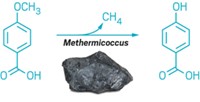Advertisement
Grab your lab coat. Let's get started
Welcome!
Welcome!
Create an account below to get 6 C&EN articles per month, receive newsletters and more - all free.
It seems this is your first time logging in online. Please enter the following information to continue.
As an ACS member you automatically get access to this site. All we need is few more details to create your reading experience.
Not you? Sign in with a different account.
Not you? Sign in with a different account.
ERROR 1
ERROR 1
ERROR 2
ERROR 2
ERROR 2
ERROR 2
ERROR 2
Password and Confirm password must match.
If you have an ACS member number, please enter it here so we can link this account to your membership. (optional)
ERROR 2
ACS values your privacy. By submitting your information, you are gaining access to C&EN and subscribing to our weekly newsletter. We use the information you provide to make your reading experience better, and we will never sell your data to third party members.
Environment
Marine Microbes Selfish With Sulfur
October 30, 2006
| A version of this story appeared in
Volume 84, Issue 44
New light has been shed on how marine organisms prevent sulfur from being released into the atmosphere so that it instead can be used as a food source. The volatile sulfur compound dimethylsulfide (DMS) is an important source of cloud condensation nuclei and thus a key regulator of Earth's climate. DMS is produced by marine microorganisms from the abundant precursor dimethylsulfoniopropionate (DMSP). This pathway competes with another route that converts DMSP into a nonvolatile biosynthetic source of sulfur and carbon. Now, the demethylase enzyme responsible for converting DMSP into a nonvolatile food source for microbes has been identified by a team led by Mary Ann Moran of the University of Georgia, Athens (Science 2006, 314, 649). This enzyme is widely distributed among marine bacteria, but they may not be the only seafaring creatures that use DMSP. Many other marine microbes, including ubiquitous diatoms, also rely on DMSP as a source of carbon and sulfur, report Maria Vila-Costa and Rafel Simó of the Institute of Marine Sciences in Barcelona and coworkers (Science 2006, 314, 652).





Join the conversation
Contact the reporter
Submit a Letter to the Editor for publication
Engage with us on Twitter